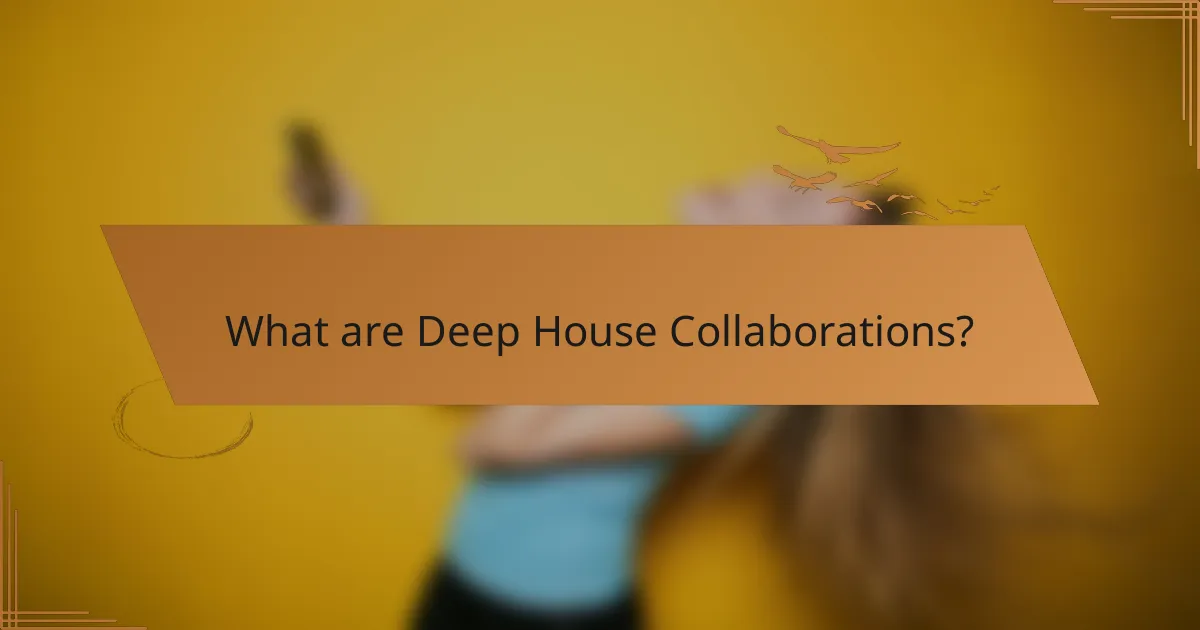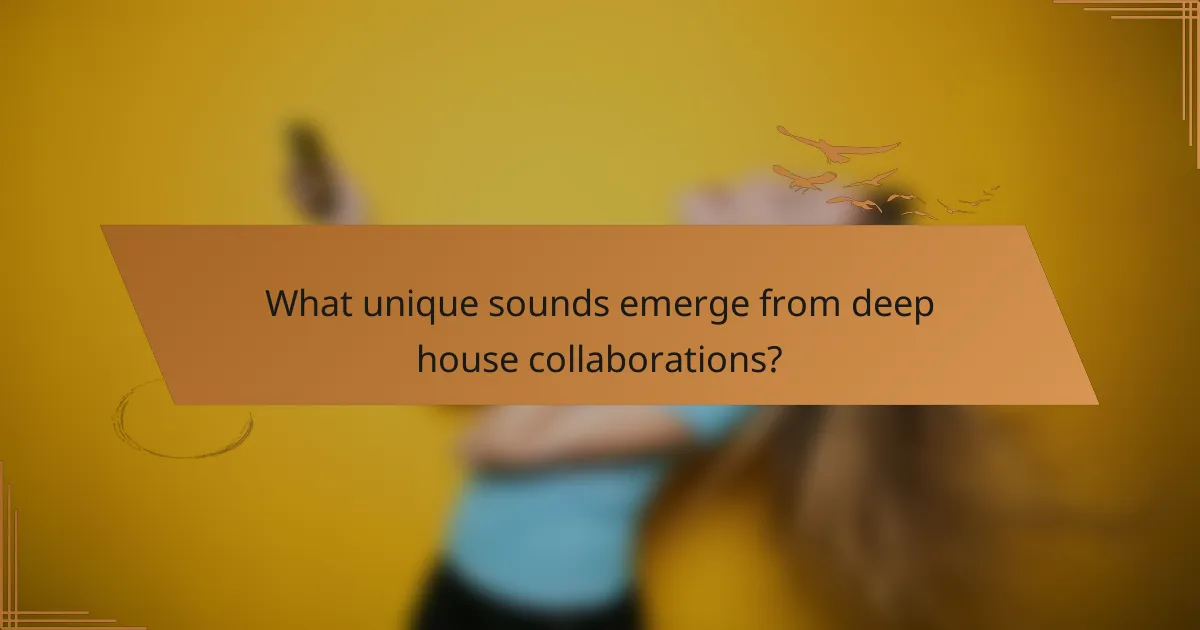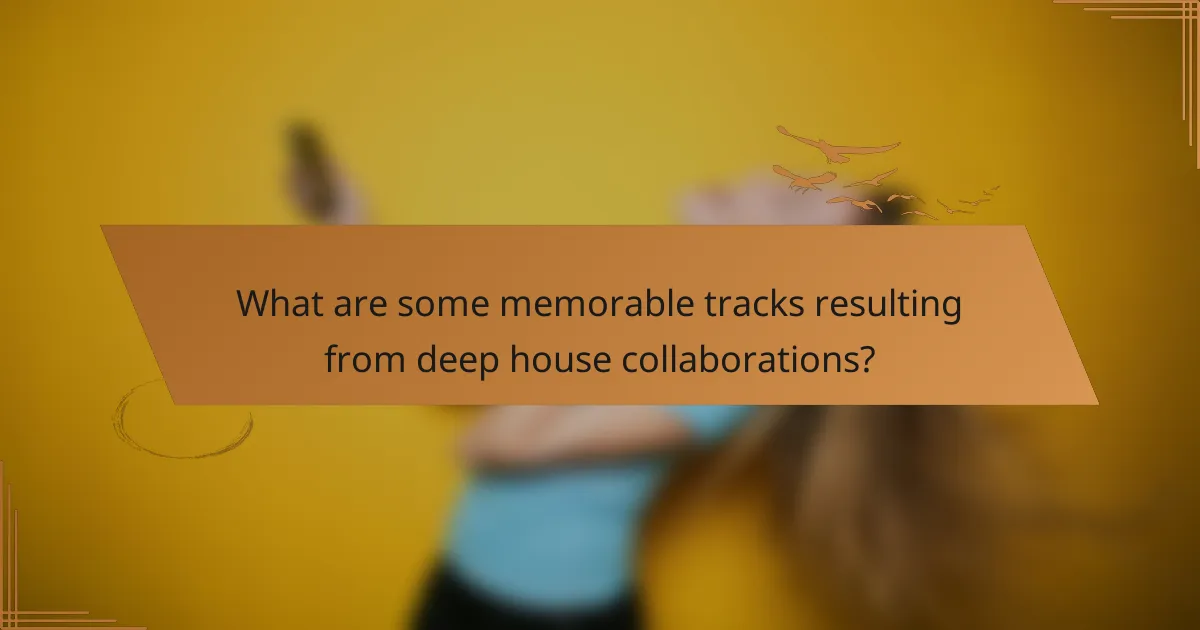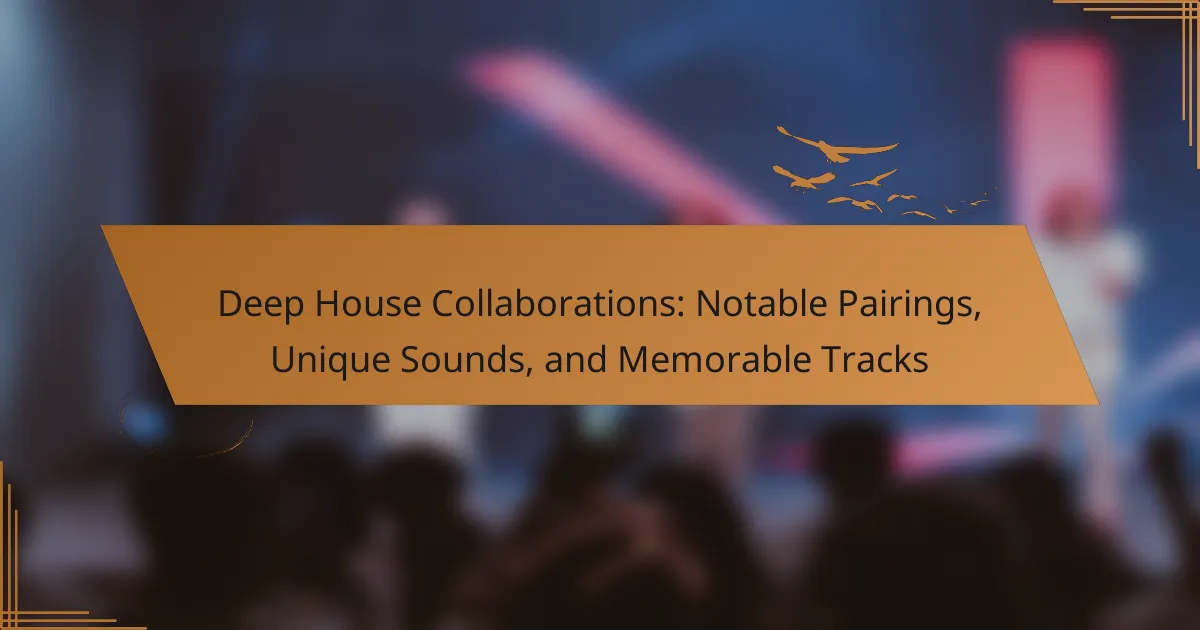Deep House Collaborations refer to musical partnerships within the deep house genre, typically involving producers, vocalists, and musicians who create unique sounds by blending their individual styles. These collaborations enhance creativity and innovation in music production, often resulting in chart-topping hits and critically acclaimed tracks. Key characteristics of deep house collaborations include rich, layered textures, diverse influences, and the incorporation of live instrumentation, which enriches the electronic beats. Memorable tracks such as “Can’t Get Enough” by Soulsearcher and “Deep Inside” by Hardrive exemplify the impactful synergy between artists, showcasing the emotional depth and engaging grooves that define the essence of deep house music.

What are Deep House Collaborations?
Deep House Collaborations are musical partnerships in the deep house genre. These collaborations often involve producers, vocalists, and musicians working together. They create unique sounds that blend their individual styles. Notable examples include artists like Disclosure and Sam Smith. These pairings result in memorable tracks that resonate with audiences. Collaborations often enhance creativity and innovation in music production. They can lead to chart-topping hits and critical acclaim. The synergy between artists often brings fresh perspectives to the genre.
How do collaborations shape the deep house genre?
Collaborations significantly shape the deep house genre by blending diverse musical influences. Artists from various backgrounds bring unique sounds and styles to the table. This fusion creates innovative tracks that push genre boundaries. Collaborations also enhance creativity through shared ideas and techniques. Notable pairings often result in memorable hits that resonate with broader audiences. For example, the collaboration between Disclosure and Sam Smith produced “Latch,” which became a deep house staple. Such partnerships can elevate lesser-known artists by providing them a platform. Overall, collaborations drive the evolution of deep house, making it a dynamic and ever-changing genre.
What roles do artists play in deep house collaborations?
Artists in deep house collaborations serve multiple roles. They contribute to the creation of the music through production and songwriting. Vocalists provide melodies and lyrics, enhancing emotional depth. DJs and producers shape the sound with mixing and arrangement skills. Collaborating artists often blend their unique styles, resulting in innovative tracks. Each artist brings distinct influences, enriching the overall sound. Their combined efforts lead to memorable tracks that resonate with audiences. This collaborative process is essential in the deep house genre, fostering creativity and diversity.
How does collaboration influence sound and style in deep house?
Collaboration significantly influences sound and style in deep house. Collaborations bring together diverse musical backgrounds and techniques. This fusion creates unique soundscapes that individual artists may not achieve alone. For example, combining vocalists with producers can enhance emotional depth in tracks. Collaborations often result in innovative production techniques and genre-blending. Notable pairings like Disclosure and Sam Smith demonstrate how collaboration can yield chart-topping hits. Additionally, collaborations can introduce fresh perspectives and inspire creativity among artists. The collective input enriches the overall quality and appeal of deep house music.
Why are notable pairings significant in deep house music?
Notable pairings are significant in deep house music because they combine unique styles and influences. These collaborations often lead to innovative sounds that push the genre’s boundaries. Artists bring their individual strengths to the partnership. This synergy can create memorable tracks that resonate with listeners. For example, collaborations between established and emerging artists can blend experience with fresh ideas. This results in a diverse sound palette that appeals to a wider audience. Additionally, notable pairings can enhance the visibility of both artists involved. This can lead to increased fan engagement and growth within the deep house community.
Which artists are considered iconic collaborators in deep house?
Iconic collaborators in deep house include artists like Larry Heard and Robert Owens. Their partnership produced classic tracks that defined the genre. Another notable duo is Masters at Work, consisting of Louie Vega and Kenny Dope. They are known for their innovative fusion of sounds. Additionally, the collaboration between Kerri Chandler and Dennis Ferrer has created memorable tracks. These artists have significantly influenced deep house music. Their work showcases unique sounds that resonate with audiences. Each collaboration has contributed to the evolution of the genre.
What impact do notable pairings have on the genre’s evolution?
Notable pairings significantly impact the evolution of the deep house genre. Collaborations between artists often lead to innovative sounds and styles. For instance, the partnership between Disclosure and Sam Smith resulted in the hit “Latch.” This track combined soulful vocals with electronic production, influencing many subsequent releases. Notable pairings can also introduce new audiences to the genre. When mainstream artists collaborate with deep house producers, they broaden the genre’s reach. Additionally, these collaborations often set trends that other artists follow. The blending of different musical influences creates a dynamic and evolving soundscape. Thus, notable pairings play a crucial role in shaping the future of deep house music.

What unique sounds emerge from deep house collaborations?
Deep house collaborations produce unique sounds characterized by rich, layered textures. These sounds often blend diverse influences from artists, creating innovative rhythms and melodies. Collaborations frequently incorporate live instrumentation, adding organic elements to electronic beats. Vocals in deep house collaborations can range from soulful to ethereal, enhancing emotional depth. The use of samples from various genres introduces unexpected sonic surprises. Distinctive basslines often emerge, providing a groove that engages listeners. Additionally, atmospheric soundscapes contribute to an immersive listening experience. These unique sounds collectively define the essence of deep house collaborations.
How do different artists contribute to the sound of deep house tracks?
Different artists contribute to the sound of deep house tracks through their unique styles and techniques. Each artist brings distinct influences, such as jazz, soul, or electronic music. Collaborations often blend these influences, creating rich soundscapes. Vocalists add emotional depth, while producers shape the overall sound with innovative beats and melodies. Instrumentalists enhance tracks with live elements, adding authenticity. The combination of these contributions results in diverse and dynamic deep house music. Notable collaborations, like those between artists such as Disclosure and Sam Smith, showcase this synergy effectively. This collaborative approach is essential to the evolution of the deep house genre.
What are the common sonic elements found in deep house collaborations?
Common sonic elements in deep house collaborations include smooth basslines, atmospheric pads, and intricate percussion. Smooth basslines provide a rich foundation for the track. Atmospheric pads create an immersive soundscape, enhancing the emotional depth. Intricate percussion adds rhythmic complexity, often featuring syncopated patterns. Vocal samples are frequently used, adding a human touch to the music. Chopped and processed vocals contribute to the overall texture. Additionally, melodic elements, such as keys or synths, are commonly layered to enrich the sound. These elements combine to create the signature sound of deep house, characterized by its groove and ambiance.
How do cultural influences shape the sound of deep house music?
Cultural influences shape the sound of deep house music by integrating diverse musical elements and traditions. The genre often incorporates jazz, funk, and soul, reflecting African American musical heritage. This blend creates rich, layered textures and rhythmic complexity. Additionally, regional sounds from the UK, Europe, and beyond contribute to its unique character. For instance, the use of ambient sounds and minimalism in European deep house showcases local cultural aesthetics. Globalization has also allowed for cross-cultural collaborations, further enriching the genre. Artists often draw inspiration from their cultural backgrounds, leading to innovative sounds. This interplay of influences results in a dynamic and evolving musical landscape within deep house.
What innovations have been introduced through collaborations?
Collaborations in deep house have introduced innovations such as genre-blending sounds and unique production techniques. Artists combine elements from various genres, creating fresh auditory experiences. For example, partnerships between deep house producers and vocalists often result in innovative lyrical themes. Collaborations also foster the use of advanced technology in music production. This includes the integration of AI tools and software for sound design. Additionally, collaborations have led to the emergence of new sub-genres, enriching the deep house landscape. Notable tracks often showcase these innovations, reflecting the creativity born from artist partnerships. The evolution of deep house continues to thrive through these collaborative efforts.
How have technology and production techniques evolved in deep house?
Technology and production techniques in deep house have evolved significantly over the years. The introduction of digital audio workstations (DAWs) revolutionized music production. Software like Ableton Live and Logic Pro allows for intricate sound manipulation. Sampling technology has also advanced, enabling producers to incorporate diverse sounds easily. The use of synthesizers has expanded, with hardware and software options available. This evolution has led to richer textures and more complex arrangements in deep house tracks. Additionally, online collaboration tools have facilitated remote partnerships among artists. These advancements have contributed to the genre’s continuous growth and innovation.
What role do remixes play in expanding the sound of deep house?
Remixes play a crucial role in expanding the sound of deep house. They introduce new interpretations and variations of original tracks. This process allows for experimentation with different rhythms and melodies. Remixes often incorporate elements from various genres, enriching the deep house sound. Notable producers can add their signature styles, creating unique versions. These adaptations can reach wider audiences through diverse musical influences. The remix culture fosters collaboration and innovation within the deep house community. Thus, remixes significantly contribute to the evolution of deep house music.

What are some memorable tracks resulting from deep house collaborations?
Memorable tracks resulting from deep house collaborations include “Can’t Get Enough” by Soulsearcher featuring the soulful vocals of Michelle Weeks. This track became an anthem in the late 90s and is regarded as a classic in the genre. Another notable collaboration is “Deep Inside” by Hardrive, which features a prominent vocal sample and is widely recognized for its influence on deep house music. “I Feel for You” by Bob Sinclar featuring Shabba Ranks showcases a fusion of deep house and reggae elements. Additionally, “Look Right Through” by Storm Queen, remixed by MK, gained massive popularity and is celebrated for its catchy melody and deep groove. These tracks exemplify the creativity and synergy found in deep house collaborations, making them memorable within the genre.
Which tracks are considered landmark collaborations in deep house?
“Can’t Get You Out of My Head” by Kylie Minogue and Fisher is a landmark collaboration in deep house. This track blends pop and deep house elements seamlessly. It became a global hit, showcasing deep house’s crossover appeal. Another significant collaboration is “Deep End” by John Summit and fellow producers. This track gained massive traction on streaming platforms. “I Feel for You” by Bob Sinclar and the Shapeshifters is also noteworthy. It highlights the fusion of house and disco influences. These collaborations have shaped the genre’s landscape and popularity. They demonstrate the versatility and innovation within deep house music.
What elements make these tracks stand out in the genre?
Tracks in deep house collaborations stand out due to their unique soundscapes, innovative production techniques, and emotional depth. Unique soundscapes often blend various musical influences, creating a rich auditory experience. Innovative production techniques, such as the use of atmospheric pads and intricate basslines, enhance the overall texture. Emotional depth is conveyed through soulful vocals and relatable lyrics. Collaborations between artists bring diverse styles, resulting in fresh and dynamic tracks. The combination of these elements often leads to memorable hooks that resonate with listeners. These characteristics contribute to the distinctiveness of tracks within the deep house genre.
How have these tracks influenced other artists and genres?
These tracks have significantly influenced other artists and genres by introducing innovative sounds and techniques. Deep house collaborations have blended elements from various genres, such as jazz, soul, and funk. This fusion has inspired a new wave of producers to experiment with similar styles. Artists like Disclosure and Kygo cite deep house tracks as foundational influences in their music. The melodic structures and atmospheric elements found in these tracks have been adopted across electronic music. Additionally, the emotional depth of deep house has influenced genres like chill-out and ambient music. This cross-pollination has led to the evolution of new subgenres within electronic music. The impact is evident in chart-topping hits that incorporate deep house elements, showcasing its lasting legacy.
What are the characteristics of successful deep house collaborations?
Successful deep house collaborations feature complementary artistic visions. These collaborations often blend distinct musical styles and influences. Effective communication between artists enhances creativity and innovation. Shared goals regarding the project’s sound and direction are crucial. A strong understanding of each artist’s strengths leads to better outcomes. Trust between collaborators fosters a productive working environment. Successful collaborations often result in tracks that resonate with audiences. Notable examples include works by Disclosure and Sam Smith, showcasing the power of collaboration in deep house music.
How do collaboration dynamics affect the quality of the music?
Collaboration dynamics significantly influence the quality of music. Effective collaboration fosters creativity and innovation among artists. When musicians with diverse skills and backgrounds work together, they can produce unique sounds. This blending of styles often leads to more complex and engaging compositions. Additionally, collaboration encourages constructive feedback, enhancing the final product. Studies show that collaborative projects often outperform solo efforts in terms of listener engagement. For instance, a 2018 study by the University of Southern California found that collaborative tracks received 30% more positive listener ratings. Thus, collaboration dynamics are crucial in elevating music quality.
What best practices can artists follow for effective collaboration?
Artists can follow several best practices for effective collaboration. Clear communication is essential. It helps to establish expectations and project goals. Regular check-ins can ensure everyone is on the same page. Artists should also be open to feedback. Constructive criticism can enhance the final product. Setting deadlines can help maintain momentum. Collaborative tools can facilitate organization and sharing. Respecting each other’s creative input is crucial for harmony. Finally, defining roles can streamline the workflow and clarify responsibilities.
What are some tips for discovering new deep house collaborations?
Explore music streaming platforms that feature curated playlists. Platforms like Spotify and Apple Music often highlight new deep house collaborations. Follow deep house labels on social media for updates. Labels frequently announce new releases and collaborations. Attend deep house events and festivals to discover artists live. These events often showcase up-and-coming collaborations. Join online communities or forums dedicated to deep house music. Members often share recommendations and new finds. Utilize music discovery apps like Shazam to identify tracks during listening sessions. This can lead to discovering collaborations you may enjoy.
Deep House Collaborations are musical partnerships within the deep house genre, involving producers, vocalists, and musicians who blend their individual styles to create innovative sounds. This article explores how collaborations shape the genre, the roles artists play, and the unique sonic elements that emerge from these partnerships. It highlights notable pairings that have influenced deep house music, the impact of technology and production techniques, and memorable tracks resulting from these collaborations. Additionally, it provides insights into best practices for effective collaboration and tips for discovering new deep house music.
